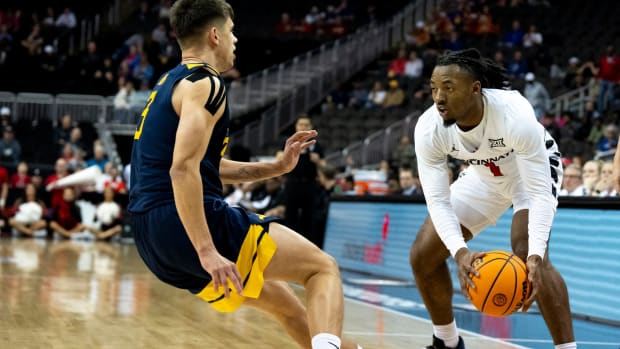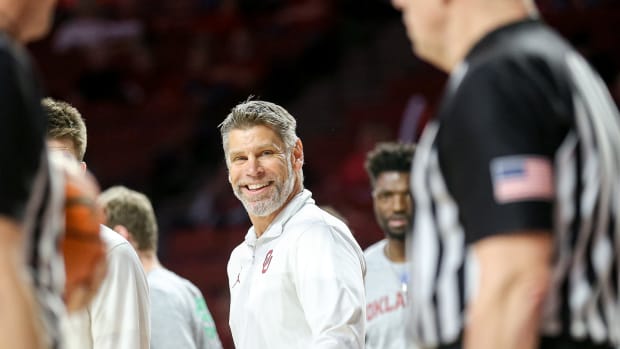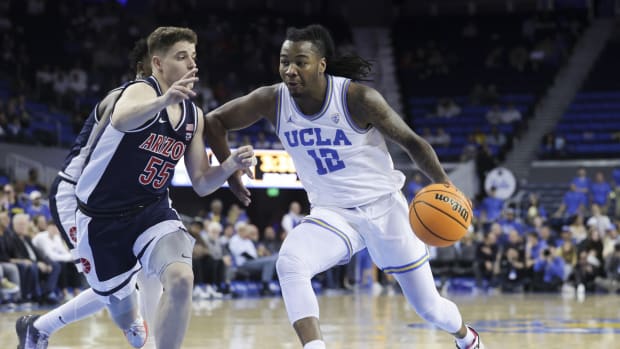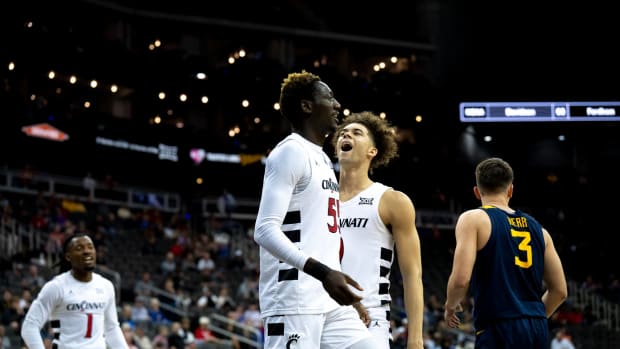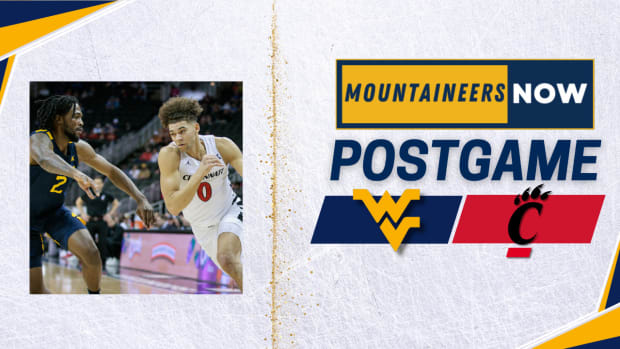Season in review: Mid-majors
The NCAA tournament tends to obscure everything that came before it in a given college basketball season. Which teams won those Thanksgiving-week nonconference tournaments? Which players were making compelling cases for national awards in December and January? The image of Kennedy Meeks, Justin Jackson, Joel Berry II, Isaiah Hicks and other North Carolina Tar Heels cutting down the nets in Glendale moments after a six-point win over Gonzaga in the title game won’t fade away soon, but in the meantime, it’s worth looking back at what else happened during the 2016-17 campaign. This is the seventh installment of a conference-by-conference review series. We’ve already reviewed the ACC, Big 12, Big East, Pac-12, Big Ten, AAC and SEC. Here's a look at the mid-majors.
Most important thing we learned: Outside of Gonzaga, those outside the power conferences didn’t get a ton of respect
Gonzaga’s No. 1 seed was a testament to the fact that it is a mid-major in name only, but Selection Sunday brought some peculiar seeding to those in smaller conferences. The most egregious decision was giving Wichita State a No. 10 seed, spurring a discussion about the value of analytics vs. resume. The analytics were highly favorable to Wichita State—which was ranked No. 8 on kenpom.com, but its lack of any marquee wins (its lone top-50 wins were over conference foe Illinois State) appeared to severely hurt it in the eyes of the committee.
The Shockers were matched up with another team that was arguably under seeded, No. 7 Dayton, in a first-round game that SI.com’s Pete Thamel later argued “never should have been played.” Wichita’s No. 10 seed had a ripple effect that could’ve dramatically altered the tournament—not only did Dayton have an unfair matchup, but No. 2 seed Kentucky couldn’t have been thrilled to have to face the Shockers in the second round. The Wildcats held on—barely—but it’s a reminder of the fickle effect seeding can have on the tournament, and why Wichita State has since bolted for a stronger conference in the AAC. While that was a boon for both the school and the AAC, it was a dagger to the Missouri Valley Conference, which will struggle even more to be respected in the future.
Best game: Nevada 105, New Mexico (Jan. 7, 2017)
This game had everything: a 25-point comeback, overtime, a second half that featured a combined 113 points, a 45-point scorer and a game-winning three with 2.9 seconds remaining.
The Lobos led 74–49 with 11 minutes remaining in regulation, which might not even be the craziest deficit the Wolfpack faced. With just 1:08 left, New Mexico led by fourteen, up 90–76. The rest of the scoring in regulation went as follows:
1:03: Charlie Tooley made three-pointer (90–79, New Mexico)
0:52: Marcus Marshall made three-pointer (90–82, New Mexico)
0:49: Jalen Harris made free throw (91–82, New Mexico)
0:40: Marcus Marshall made three-pointer (91–85, New Mexico)
0:36: Elijah Brown made free-throw (92–85, New Mexico)
0:28: Jordan Caroline made three-pointer (92–88, New Mexico)
0:27: Jalen Harris two made free throws (94–88, New Mexico)
0:18: Marcus Marshall made three-pointer (94–91, New Mexico)
0:07: 0:18: Marcus Marshall made three-pointer (94–94)
Nevada went 6-for-6 on three-pointers in the game’s final 63 seconds of regulation, including four by Marshall. So it was only fitting that, with the Wolfpack down two, Caroline hit a game-winning three in overtime. He finished the night with 45 points and 13 rebounds, while Marshall added 26 points.
Best player: Marcus Keene, Central Michigan
Keene put on quite the show during the 2016–17 season. The 5’9” guard scored at least 30 points on 17 occasions, hit the 40-point mark seven times and poured in 50 points while shooting 10 of 15 from three in a Jan. 21 win, which was the first Division I 50-point game since 2013. His pursuit of a 30 points-per-game average in the regular season fell just short, but a 41-point performance in the Chippewas’ MAC tournament loss gave him a total season average of 30.0 points on 44.7% shooting, plus 4.5 rebounds and 4.9 assists. Keene logged 92.8% of the possible minutes he could have played, the fourth-highest mark in the country, per kenpom.com. He finished with a true shooting percentage of 58.1%.
Besides his 50-point game, perhaps Keene’s most notable moment of the season was when, late in a close December game, he nonchalantly dribbled the ball behind his back while spinning before draining a long three-pointer in the face of a Green Bay defender. After the season, Keene announced he would forgo his senior year and enter the NBA draft.
Nonconference scheduling is changing, but what does that really mean?
Best coach: Mark Few, Gonzaga
What a year it was for Mark Few. The Zags’ leader had been to the NCAA tournament in all of his previous 17 seasons as a head coach, but his teams had never broken through to the promised land that is the Final Four. Before 2017, the closest the Bulldogs had gotten was an Elite Eight trip in 2014–15. So while Gonzaga entered the 2017 tourney as a No. 1 seed with a nearly unblemished 32–1 record, many still had a healthy dose of skepticism. Would this really be the year that was different?
The Zags had been a No. 1 seed before (2013), and they had gone 17–1 in West Coast Conference play before. But the secret ingredient of this year’s team was its defense, which finished the year ranked first in the nation in adjusted defensive efficiency, per kenpom.com. Few had assembled a team that had 7’1” Przemek Karnowski in the post, backed up by 7’0” freshman Zach Collins, and he’d used the transfer route to add Nigel Williams-Goss and Jordan Mathews to a team that was destined to go further than any of its Bulldogs predecessors, not only reaching that first Final Four but finishing as national runners-up.
Best newcomer (freshman/transfer): Nigel Williams-Goss, Gonzaga
The aforementioned Williams-Goss was Gonzaga’s anchor on both offense and defense, leading the country in Win Shares (8.1) and leading the Bulldogs in points (16.8), assists (4.7) and steals (1.7) while shooting 48.6% from the floor and 86.7% from the free-throw line. Williams-Goss spent the first two years of his career at Washington, where he had a pair of strong seasons before transferring and sitting out 2015–16. That Gonzaga team certainly could have used him, but the timing of his move ultimately couldn’t have been better, given the roster he was joining.
In the Zags’ critical Sweet 16 and Elite Eight wins,—over Xavier and South Carolina, respectively—Williams-Goss scored 23 points apiece. He struggled from the floor in the national title game, shooting 5 of 17, but added nine rebounds and six assists while logging 39 minutes and would’ve almost surely been named the Final Four’s Most Outstanding Player had the Bulldogs taken home the title.
Biggest surprise: Wichita State
Wichita State having a strong season isn’t in itself a surprise. The Shockers entered the season riding five straight NCAA tournament appearances and seemingly being an annual mid-major contender. But the 2016–17 Shockers had to overcome the graduation of four-year duo Fred VanVleet and Ron Baker, and an upstart Illinois State was threatening to dethrone them in the Missouri Valley Conference. How did Gregg Marshall’s team respond? After a Jan. 14 loss to the Redbirds seemed to shake up the status quo in the MVC, Wichita State ripped off 12 straight wins to close the regular season (including a 41-point revenge rout of Illinois State), then rolled through Arch Madness to stand at 30–4 heading into the Big Dance.
Unfortunately for the Shockers, the NCAA Selection Committee put a lot of weight on their lack of top-25 wins and handed them a controversial No. 10 seed, despite a top-10 kenpom.com rank. Wichita took down No. 7 seed Dayton in the first round before nearly topping No. 2 Kentucky, taking the Wildcats to the wire in a 65–62 loss. But it was a successful season for the Shockers, who weren’t quite as good defensively as they were a season ago but featured an improved offense behind Markis McDuffie, Landry Shamet, Darral Willis Jr. and Shaquille Morris.
Biggest disappointment: San Diego State
From 2010–2015, the Aztecs earned six straight trips to the NCAA tournament, a run that came to an end with a loss in the Mountain West final in 2016. San Diego State seemed likely to return to the Big Dance heading into 2016–17, picked to win the conference and with three starters returning. The Aztecs are known for their elite defense, which again led the conference in efficiency this season, but it was a step below the one that carried them in recent years and there wasn’t enough offense to make up for the difference.
Instead, San Diego State tumbled to a sixth-place finish in the Mountain West and a 19–14 overall mark, which included losses to Loyola Chicago, Grand Canyon and Air Force. Junior Trey Kell and sophomore Jeremy Hemsley led the team in scoring, and while junior Malik Pope made strides after a disappointing sophomore year, he missed nine games in the first half of the season due to injuries.
One burning off-season question: Who will emerge as the top teams outside the power conferences?
The mid-major ranks are losing a lot at the top this off-season: Gonzaga loses four of its top five scorers, longtime stalwart Wichita State has joined the AAC, Valparaiso star Alec Peters has graduated, NCAA Cinderella Middle Tennessee loses JaCorey Williams and Reggie Upshaw and standout UNC Wilmington lost its coach, Kevin Keatts, who left for the NC State job, and top scorer C.J. Bryce, who followed Keatts to Raleigh.
Who will step up in 2017–18? The most likely teams remain familiar ones: Gonzaga still figures to be a factor despite its departures, but it will face a tough challenge from WCC rival Saint Mary’s, which once again returns the bulk of its scoring. Jock Landale is back for his senior year and figures to be among the nation’s best players, and he’s joined by Calvin Hermanson and Emmett Naar. Also keep an eye on Harvard in the Ivy League—the Crimson return a strong young core that include rising sophomores Bryce Aiken and Seth Towns—and on the Sun Belt’s UT Arlington, which will be led by senior Kevin Hervey.

